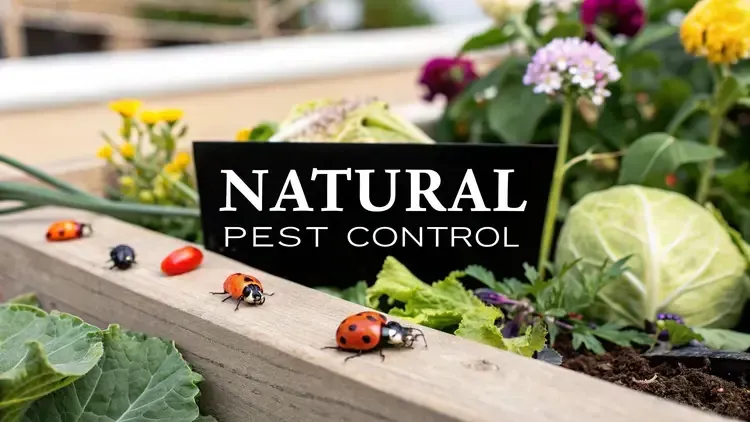
Natural Pest Control for a Thriving Garden
Natural Pest Control for a Thriving Garden
Let's be honest: Natural pest control isn't about finding a magic organic spray. It’s a philosophy. It’s about working with nature, not declaring war on it. Instead of grabbing a chemical bottle, you learn to use biological, cultural, and mechanical methods to manage pests in a way that doesn’t poison the whole neighborhood.

Your Garden Is A Community
Picture your garden for a moment. Is it a sterile, manicured plot where anything that moves is an enemy? Or is it a bustling, living ecosystem where every organism has a job to do?
If you want to master natural pest control, you have to lean into that second vision. Pests, from aphids to hornworms, aren't just villains to be wiped out. They're often messengers, telling you something is out of whack. Adopting this mindset means shifting your goal from total eradication to simple, effective balance.
Think of it like this: a healthy, resilient garden can pretty much defend itself, just like a healthy person can fight off a cold without needing a hospital visit. The fact that a few pests show up is actually a good sign. It means you’re growing food that’s good enough for nature to want a bite!
The Core Idea: Be a Garden Steward, Not a Warrior
At its heart, the philosophy is simple. Instead of waging a chemical war on every bug you see, you create an environment where pests either don't want to live or their populations are kept in check by their natural enemies. It’s about observation and patience, learning to read the quiet signals your garden sends.
This approach is built on prevention first, intervention second. You’re building a strong, robust system from the ground up.
The goal isn't a pest-free garden. That’s a fantasy. The goal is a balanced garden where a thriving ecosystem does most of the pest management for you.
The benefits of this approach ripple out far beyond your garden fence. When you skip the synthetic pesticides, you’re protecting bees and butterflies, keeping birds safe, and stopping harmful chemicals from washing into our streams and rivers.
Here's a breakdown of the core principles that guide this approach.
Key Principles of Natural Pest Control
This table shows the shift in thinking from conventional pest management to a more holistic, nature-driven strategy. It’s less about reacting and more about building a system that regulates itself.

Ultimately, these principles create a garden that is not only productive but also resilient and largely self-sufficient.

A Movement That's Gaining Ground
This isn't just a trend for backyard gardeners. It's a global shift, pushed by people who want healthier food and a cleaner planet. Regulations on chemical pesticides are getting stricter, and the demand for natural solutions is skyrocketing.
Just look at the numbers. The global market for natural enemy pest control (using beneficial insects) was valued at around $19.2 billion in 2025 and is on track to hit $32.8 billion by 2035.
That kind of growth sends a clear message. Both small-scale growers and massive farms are realizing that working with nature isn’t just idealistic—it’s practical, sustainable, and delivers real, long-term results.
Recruiting Your Garden's Natural Allies
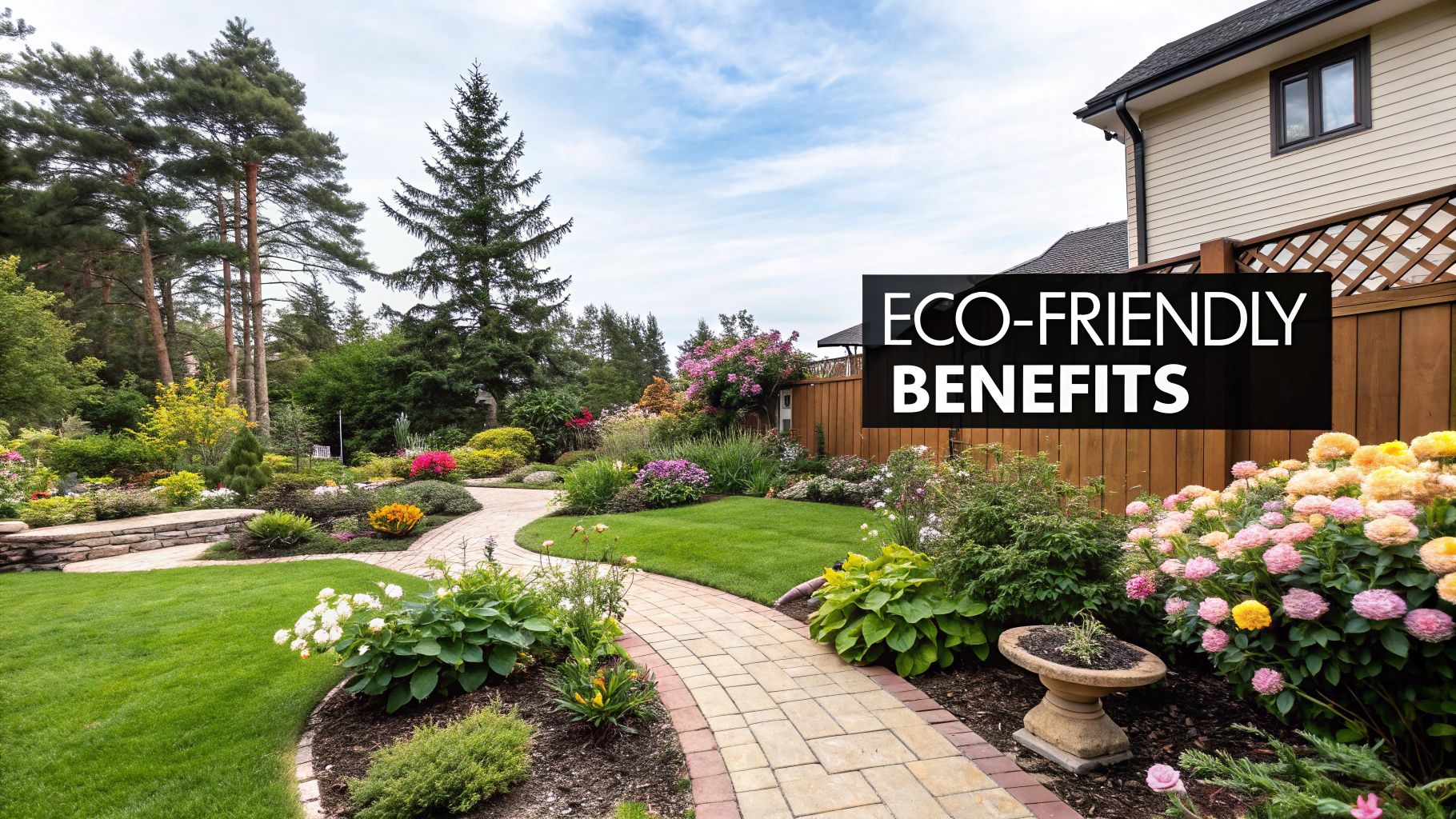
The best natural pest control isn't about what you fight—it's about who you invite. At its heart, biological control means turning your garden into a self-regulating ecosystem. Instead of waging a constant war on pests, you're building a tiny neighborhood where a microscopic security team keeps the troublemakers in line for you.
Think of it like being a habitat manager, not a warrior. Your job is to recruit powerful allies that naturally take care of the bugs that would otherwise overrun your precious plants.
The most effective pest management isn’t about what you remove from your garden, but what you bring into it. By creating a habitat for beneficials, you build a resilient ecosystem that defends itself.
This approach flips the script entirely. You’re not just growing vegetables; you’re cultivating a complete, thriving ecosystem where nature’s own checks and balances do the heavy lifting.

Meet Your Biological Control Team
Your recruitment strategy should focus on three distinct types of natural allies, each with a unique skill set for tackling pests. Knowing their roles is the first step toward putting them to work in your garden.
Predators: These are the frontline hunters. Think of ladybugs and their larvae, which can gobble up to 50 aphids a day, or the stealthy spiders that hunt a wide range of insects. They actively seek out and consume pests.
Parasitoids: These allies are more specialized and incredibly effective. Parasitoids, like certain tiny, non-stinging wasps, lay their eggs on or inside a specific host pest. When the larvae hatch, they consume the pest from the inside out, stopping it from ever reproducing.
Pathogens: These are your unseen microscopic warriors. Beneficial bacteria, fungi, and nematodes can be introduced to infect and kill specific pests without harming your plants or other helpful insects. A classic example is Bacillus thuringiensis (Bt), a bacterium that only targets cabbage worm caterpillars.
Creating a Five-Star Resort for Your Allies
Simply releasing a box of ladybugs isn't enough; you have to convince them to stick around. This means creating an attractive environment—a five-star resort where your allies can live, thrive, and reproduce. A welcoming habitat is the key to long-term natural pest control.
Your goal is to provide the three essentials: food, water, and shelter.
Plant a Diverse Buffet: Many adult beneficials, like ladybugs and lacewings, also feed on nectar and pollen. Planting a mix of small-flowered plants like alyssum, dill, yarrow, and cosmos provides a steady food source, keeping them in your garden even when pest numbers are low. This ensures your security team is always on standby.
Offer a Water Source: A shallow dish filled with pebbles and water creates a safe place for insects to drink without drowning. This simple feature can be a huge draw for your allies, especially during hot, dry spells.
Provide Shelter and Overwintering Spots: A perfectly sterile garden is a lonely one. Leaving some leaf litter or creating a small "bug hotel" with hollow stems and pinecones gives predators a place to hide and spend the winter, ensuring they return year after year. This is a fantastic way to support the beneficial insects that protect your berry patches.
A small beneficial insect house gives your garden allies a safe, permanent place to live — and guarantees they’ll be back next season to keep pest populations in check.
This isn't just a quaint garden trick; it's a strategy that has been scaled for massive success in agriculture and forestry. For example, releasing parasitic wasps to combat scale insects has shown incredible results, with some studies reporting parasitism rates as high as 96.28%. You can explore the full findings on parasitoid effectiveness from forestry applications. By building this system, you create a garden that is not only productive but also resilient and truly alive.
Using Smarter Sprays and Powders

While prevention and a garden full of biological allies are the cornerstones of natural pest control, sometimes a pest population just explodes. When that happens, you need a more direct approach.
This is where botanical and mineral-based sprays and powders come in. Think of them not as broad-spectrum weapons, but as targeted tools for specific, acute problems. Unlike synthetic chemicals that hang around in the environment, these smarter solutions break down quickly and work in clever ways. The key is knowing which one to use, and using it sparingly.
Plant-Based Botanical Sprays
Botanical sprays use compounds derived from plants to disrupt pests. They can be highly effective, but you have to apply them with care—some can harm the good guys, too, if used at the wrong time or in the wrong way.
Neem Oil: This is a true multi-tool for the organic gardener. Extracted from the neem tree, it works by messing with insect hormones, stopping them from feeding and reproducing. It’s a solid choice for aphids, mites, and whiteflies, but be patient. It works over days, not instantly.
When you need a precise intervention, neem oil is my go-to. it stops pests in their tracks without wrecking the balance of your garden ecosystem.

Insecticidal Soap: A simple but brilliant solution. This spray uses potassium salts of fatty acids to wash away an insect's protective outer layer, causing it to dehydrate. It's fantastic for soft-bodied pests like aphids and spider mites, but it must make direct contact to work.
Pyrethrins: Derived from chrysanthemum flowers, pyrethrins are fast-acting nerve toxins for insects. They’re effective against a wide range of pests but can also harm bees, so only use them in the evening after your pollinators have gone home for the night.
Remember: Just because a spray is "natural" doesn't mean it's harmless. Always apply these solutions late in the evening to minimize contact with active pollinators like bees and other beneficial insects.
Mineral-Based Powders and Barriers
Mineral-based controls offer a physical, rather than chemical, line of defense. They are powerful allies when you use them strategically to create no-go zones for creepy crawlies.
One of the most valuable mineral powders is diatomaceous earth (DE). This fine, white powder is made from the fossilized remains of tiny aquatic organisms called diatoms. To us, it feels soft, but on a microscopic level, its edges are razor-sharp.
When a soft-bodied insect like a slug, ant, or earwig crawls across DE, the particles scrape away its waxy outer layer, causing it to dehydrate and die. This physical action makes it an excellent barrier to sprinkle around the base of vulnerable plants.
Applying these natural solutions requires precision. For example, if you're dealing with persistent cabbage worms or loopers, a targeted approach is crucial. You can see how to combine these methods in our guide to natural kale pest control. The goal is always to intervene surgically, solving the immediate problem while protecting the long-term health of your garden.
Building a Pest-Resistant Garden Foundation
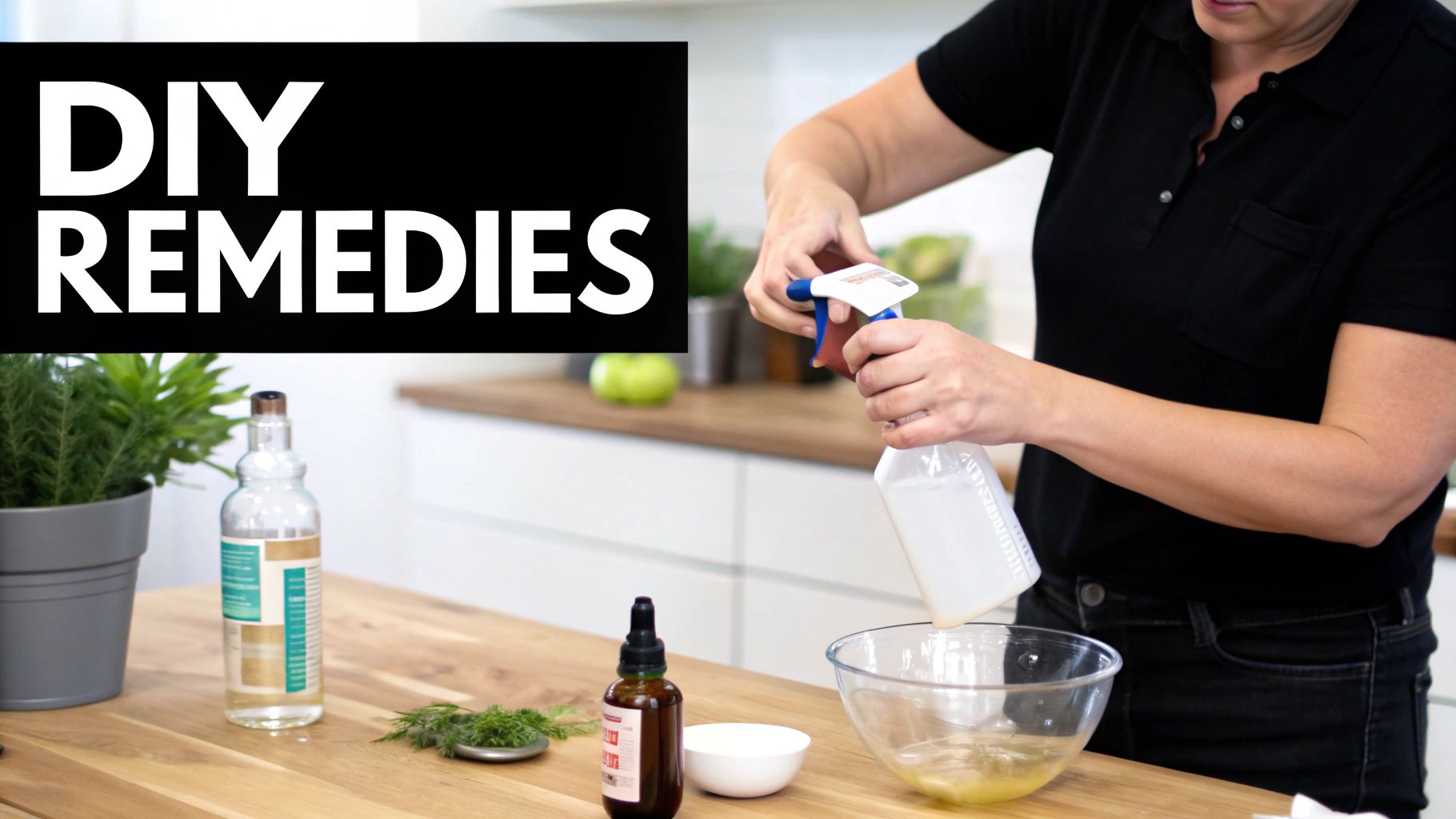
The most powerful form of natural pest control isn't a spray you apply after you find a problem. It’s the smart gardening habits you build from the very beginning. These foundational practices—what we call cultural and mechanical methods—are what prevent pests from ever getting a foothold in the first place.
Think of it as building a fortress for your plants, one good habit at a time. This approach is all about creating an environment that’s naturally unwelcoming to pests. By disrupting their life cycles and blocking their access, you can solve most pest problems before they even start. It’s proactive strategy, not reactive warfare.
Cultivating a Healthy Garden Culture
Cultural controls are the "good housekeeping" of gardening. They’re simple, they don't cost much (if anything), and they are incredibly effective at creating a resilient garden that pests just don't want to live in.
Crop Rotation: This is a big one. Never plant the same crop family in the same spot year after year. Pests that zero in on specific plants, like tomato hornworms or squash vine borers, often overwinter in the soil right where their favorite food was. Moving their food source confuses them, breaks their life cycle, and stops their populations from exploding.
Companion Planting: This age-old strategy is like creating a buddy system for your plants. Some plants, like marigolds, release compounds into the soil that repel nematodes. Others, like aromatic herbs such as basil and rosemary, can confuse insects like carrot flies that hunt by smell.
Garden Sanitation: A messy garden is a pest paradise. Decomposing leaves, weeds, and fallen fruit provide the perfect hiding spots and breeding grounds for slugs, squash bugs, and fungal diseases. A regular cleanup removes these havens and dramatically lowers pest pressure.
When you weave these habits into your gardening rhythm, your garden becomes a much harder target. Strong, healthy plants are also naturally more resistant to attack. You can learn more about how to build that strength in our guide on using natural fertilizer for vegetables, which is a key part of this whole-system approach.
Using Physical Barriers and Direct Action
Mechanical controls are your hands-on, physical tactics for stopping pests in their tracks. These methods are direct, completely non-toxic, and give you immediate solutions for specific problems.
The simplest solutions are often the most effective. A physical barrier or a strong jet of water can be more powerful than any chemical spray by preventing the problem from escalating.
One of the most useful mechanical controls is the floating row cover. This lightweight fabric creates a physical barrier that lets in sunlight, air, and water but keeps out flying pests like cabbage moths and flea beetles. Covering vulnerable crops from the moment you plant them is a total game-changer for prevention.
If you haven’t tried them yet, grab a set of floating row covers — they’re one of the simplest ways to protect tender crops without ever reaching for a spray bottle.
Companion planting is a fantastic cultural control method that uses the natural abilities of plants to protect one another. Below is a quick-reference table to help you get started with some common and effective pairings.
Companion Planting for Pest Management

These pairings aren't just folklore; they work by creating a more complex and confusing environment for pests, making it harder for them to find and damage their target crops.
Other simple but effective mechanical tactics include:
Hand-Picking: For larger pests like tomato hornworms, Japanese beetles, or squash bugs, the most effective tool is your own two hands. A daily patrol to pick them off and drop them into a bucket of soapy water can keep their numbers in check before they multiply.
Water Jets: A strong spray of water from the hose is surprisingly good at dislodging small, soft-bodied insects like aphids and spider mites. It won't eliminate them completely, but it can knock their population back enough for beneficial predators to move in and take over.

Creating Your Natural Pest Control Plan
Taking all these concepts and turning them into a real-world strategy can feel like a big leap, but it’s simpler than you might think. The goal is to create a straightforward, repeatable plan that works for your garden. This framework, often called Integrated Pest Management (IPM), is what separates a reactive gardener from a proactive one.
An IPM approach isn’t about grabbing the first spray bottle you see. It's built on observation and thoughtful action. It’s about making smart, informed decisions that protect your garden’s long-term health, turning natural pest control from a mystery into a clear path forward.
Step 1: Identify Your Pest Correctly
Before you can solve a problem, you have to know exactly what it is. Is that a beneficial lacewing larva munching on aphids, or a destructive pest getting ready to lay eggs? Misidentification is a common mistake that can lead you to accidentally harm your garden’s most important allies.
Slow down and observe. Look at the damage on the leaves, flip them over to check for culprits, and note what time of day the pests are most active. A quick online search with a simple description like "tiny green bugs on kale" often points you to a correct ID and a targeted, effective solution.
Step 2: Set Your Action Threshold
A core principle of natural pest control is accepting that a completely pest-free garden isn't realistic—or even desirable. An "action threshold" is simply the point at which a pest population becomes large enough to cause unacceptable damage, signaling that it's time for you to step in.
For example, a few aphids on a single kale plant might be no big deal; ladybugs will likely find them soon enough. But if those aphids multiply and spread to several plants, causing leaves to yellow and curl, you’ve crossed your threshold. This mindset prevents unnecessary panic and keeps you from intervening when nature is already handling it.
This balanced approach is gaining serious traction. The Agri Natural Enemy Pest Control Market shot up from $19.67 billion in 2024 to $21.03 billion in 2025 and is on track to hit $30.35 billion by 2029. This isn't just a trend; it's a major shift toward sustainable, nature-based solutions. You can discover more insights about these market trends and see how the industry is evolving.
Step 3: Monitor for Early Warnings
The absolute best way to manage pests is to catch them early. Make it a habit to walk through your garden every day or two, specifically scouting for trouble. Check under leaves, inspect new growth, and look for any signs of stress.
A five-minute daily walk-through can prevent a week-long battle. Early detection is your single greatest advantage in managing garden pests effectively.
This constant monitoring lets you spot issues before they become full-blown infestations, making them much easier to handle with simple, non-toxic methods.
The infographic below shows a simple workflow for when you decide it's time to introduce beneficial insects as part of your plan.
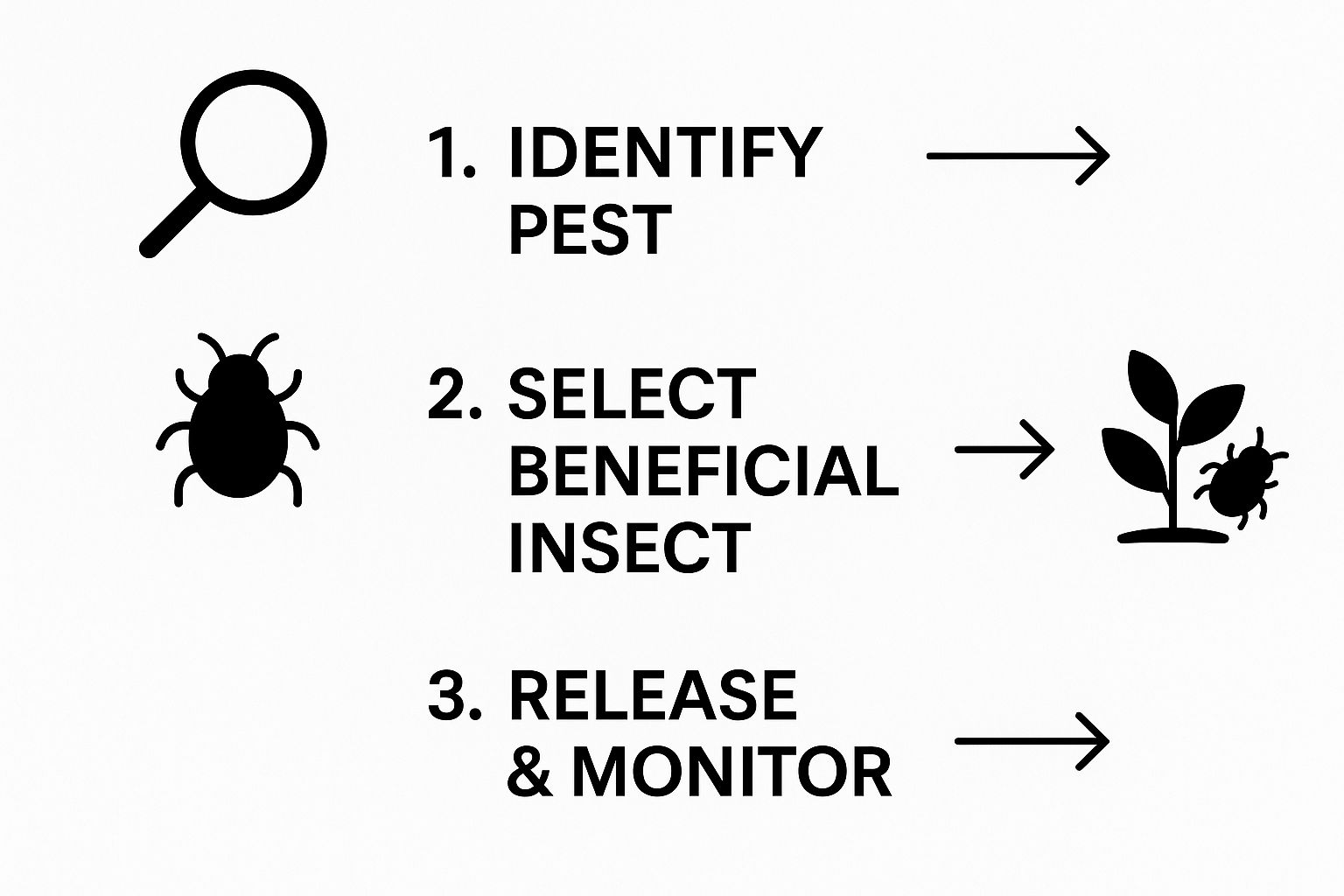
As you can see, successful biological control always starts with accurate identification, followed by thoughtful selection and careful monitoring.
Step 4: Choose the Least-Toxic Control First
Once you’ve identified a pest and decided it's time to act, always start with the simplest, least-disruptive method available. Think of it as a ladder, and you always start on the lowest rung.
Mechanical/Physical: Can you just hand-pick the pest off the plant? Can you knock them off with a sharp spray of water from the hose? Could a physical barrier like a row cover keep them out entirely?
Biological: Can you give it a day or two for natural predators to show up? Or is it time to introduce beneficial insects like ladybugs or lacewings to do the work for you?
Botanical: If the problem persists and gets worse, can you use a targeted, short-lived spray like insecticidal soap or neem oil? If so, always apply it in the evening to protect pollinators.
Following this hierarchy ensures you do the least amount of harm to your garden’s delicate ecosystem while still solving the problem at hand.
Common Questions About Natural Pest Control
Making the switch to natural pest control feels like learning a new language. You're moving away from the old habits of reactive chemical warfare and stepping into a role of proactive garden stewardship. It’s only natural to have a few questions.
Let's clear the air on the big three worries that come up time and time again: effectiveness, timing, and cost. Getting these straight will help you start this journey with confidence, knowing a healthy, resilient garden is well within your reach—no harsh chemicals required.
Are Natural Methods as Effective as Chemical Pesticides?
Yes, but they play a completely different game. Chemical pesticides are designed for one thing: a fast, indiscriminate kill. They’re the bomb you drop on a problem, wiping out the target pest but also taking down beneficial insects, pollinators, and crucial soil life as collateral damage.
Natural methods, on the other hand, are all about long-term prevention and building balance. Think of it less like an instant cure and more like building a robust immune system for your garden. While a botanical spray like insecticidal soap can offer a quick knockdown for a sudden aphid explosion, its real power comes from being part of a combined strategy.
The goal isn't just to kill pests; it's to create an ecosystem so resilient that pest populations rarely get out of control in the first place.
When you start attracting beneficial insects, focusing on soil health, and practicing smart crop rotation, you're building a system that becomes more effective and self-regulating over time. Here, "effectiveness" isn't measured by a bug body count, but by the garden's overall health and ability to bounce back.

How Long Does Natural Pest Control Take to Work?
This really depends on what you’re doing. It’s helpful to think about your actions in two different buckets: the quick fixes and the long-term foundations.
Direct Actions (Immediate Results): These are your frontline responses for problems that are staring you in the face. Hand-picking a tomato hornworm, blasting aphids off a plant with a jet of water, or applying insecticidal soap to a patch of spider mites—these all show results right away. You are physically removing or neutralizing the threat in that moment.
Foundational Strategies (Results Over Time): These are the long-term investments in your garden's health. Building rich soil with compost, planting a patch of flowers to attract ladybugs, and rotating where you plant your tomatoes each year are strategies that build strength over an entire growing season and beyond. The payoff is a garden that needs far less of your intervention down the road.
A little patience is part of the process. You're not just fighting this season's pests; you're actively preventing next season's infestations from ever getting a foothold.
Is Organic Pest Control More Expensive?
This is one of the biggest myths out there. While you might have a few small upfront costs, natural pest control is almost always more cost-effective in the long run.
Your initial investment might look something like this:
A one-time purchase of garden mesh or a floating row cover.
A $3 packet of seeds for flowers that attract beneficial insects.
A single bottle of neem oil that will last you for several seasons.
Now, consider this: many of the most powerful natural methods are completely free. Making your own compost from kitchen scraps, rotating your crops, using water from your hose, and simply letting nature's predators do their job costs you nothing but a bit of time and observation.
Compare that to the cycle of buying new bottles of chemical sprays year after year. By investing in the health of your garden's ecosystem, you build a self-sustaining system that needs fewer and fewer purchased inputs. That saves you real money, season after season.
Are you ready to build a healthier, more resilient garden? At The Grounded Homestead, we provide the knowledge and support you need to grow your own food confidently and sustainably. Start your journey with us today!

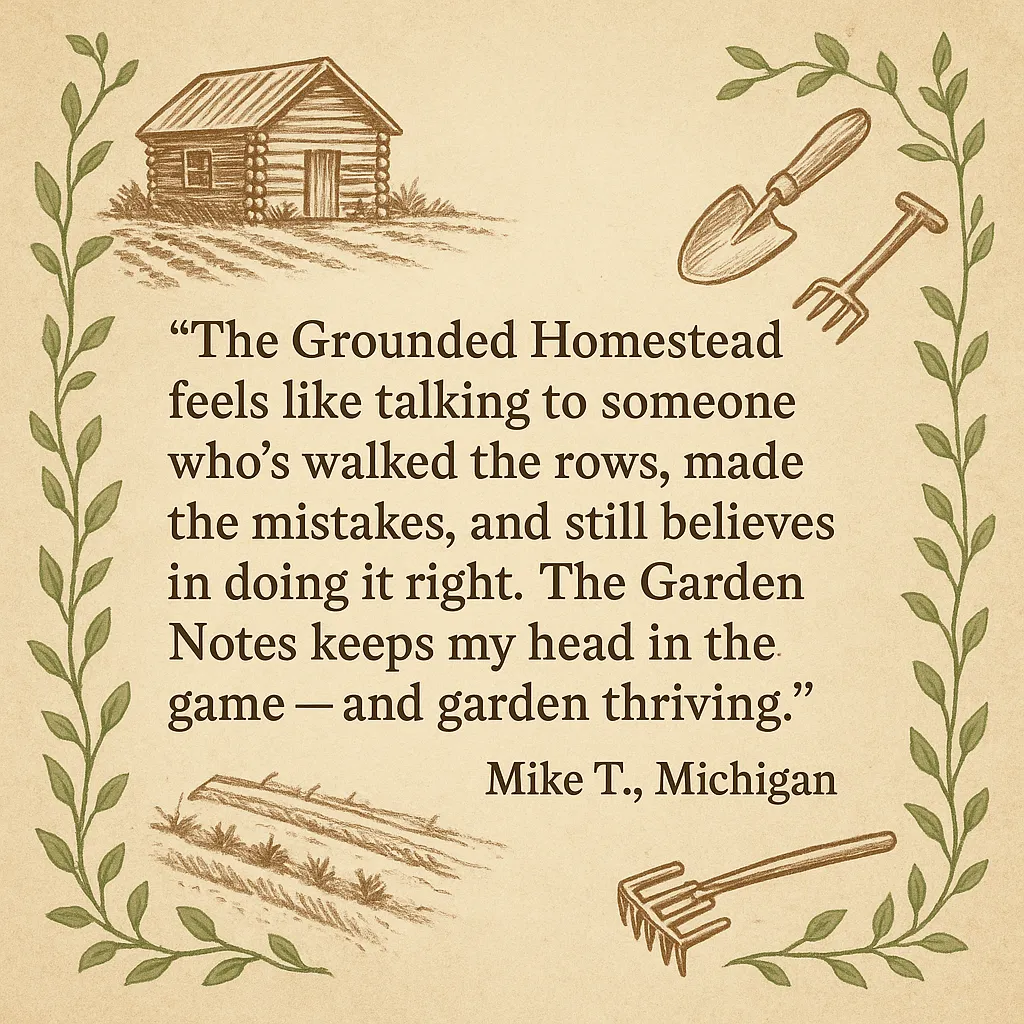
Facebook
Instagram
X
Youtube